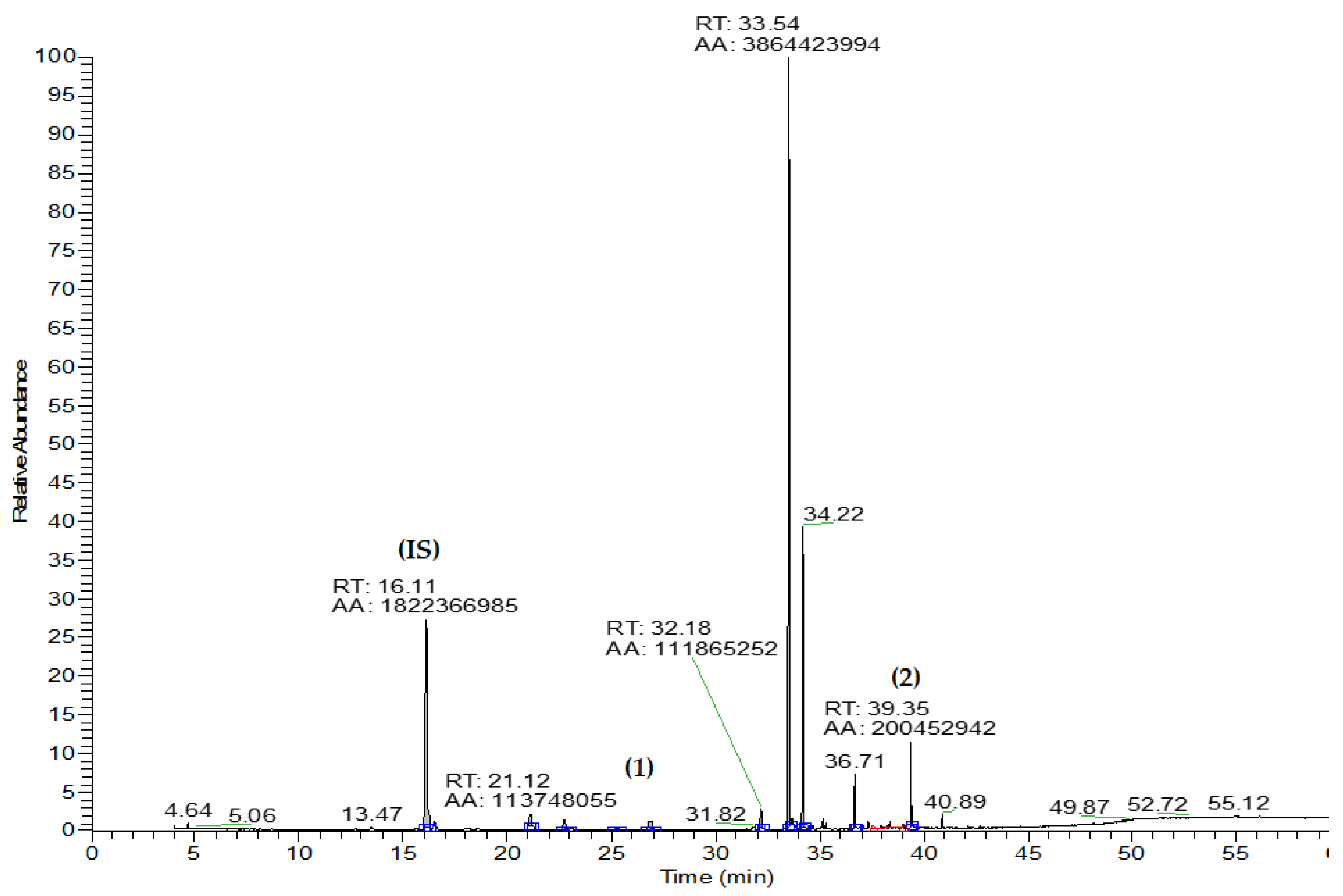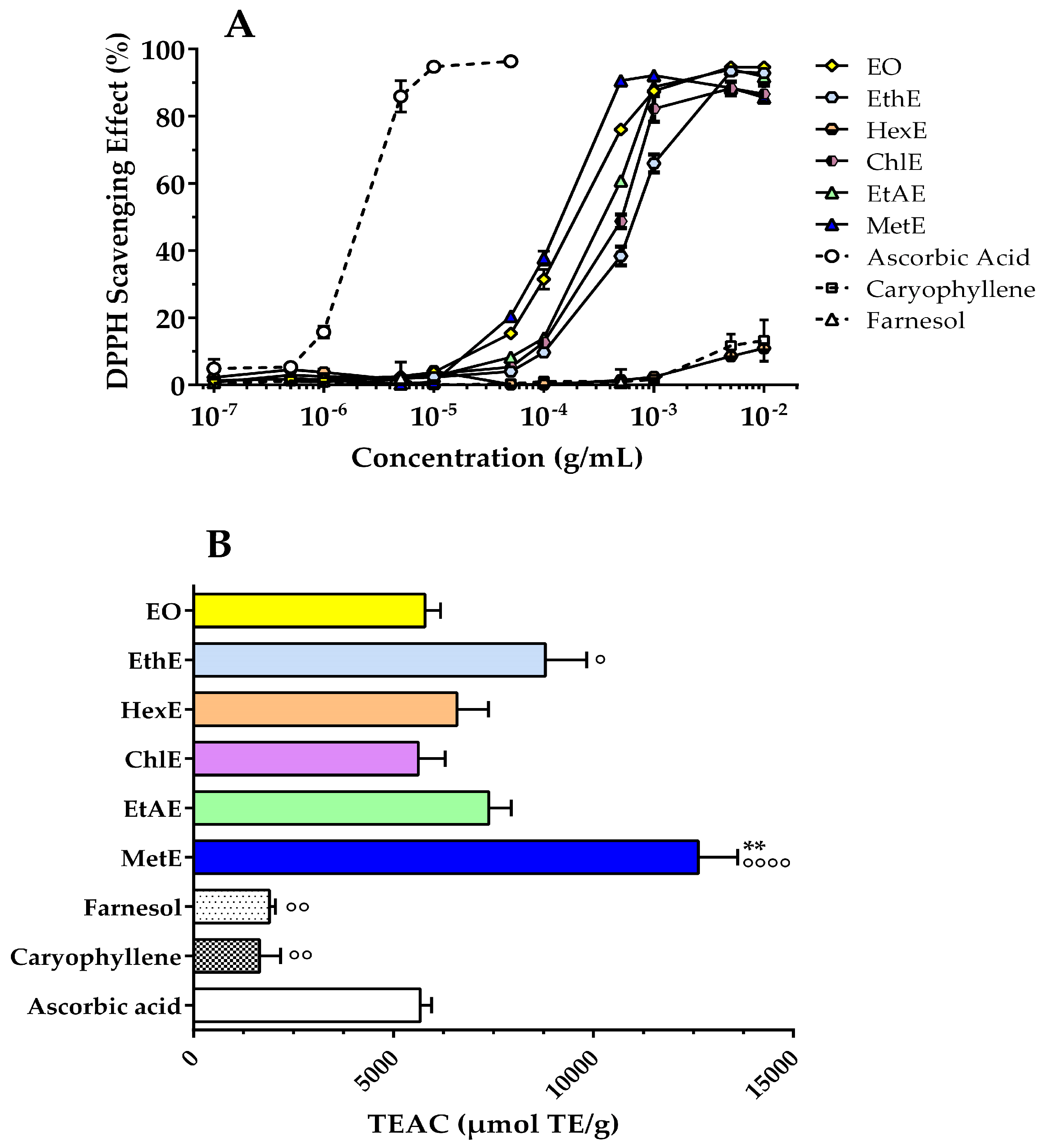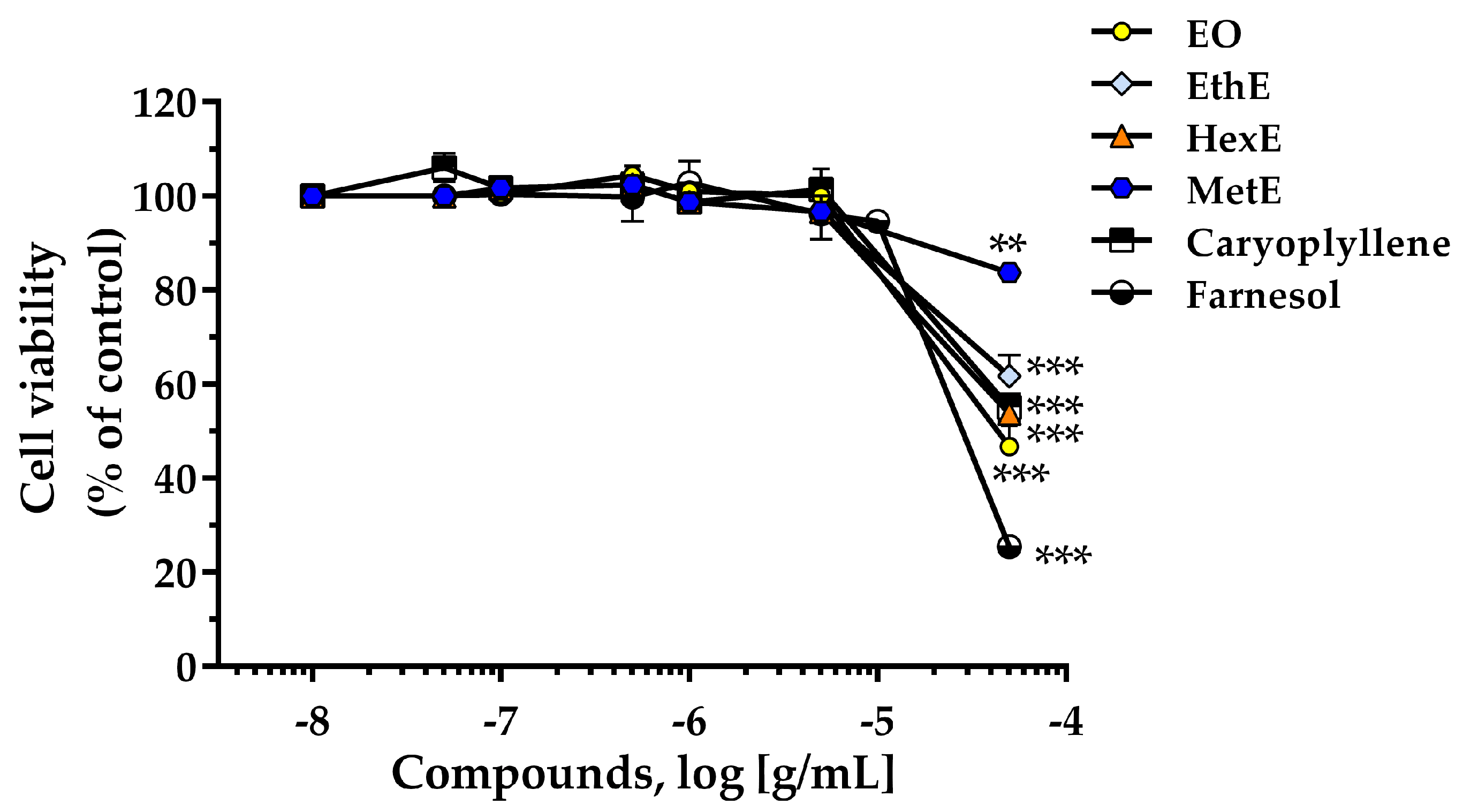Pterodon emarginatus Seed Preparations: Antiradical Activity, Chemical Characterization, and In Silico ADMET Parameters of β-caryophyllene and Farnesol
Abstract
1. Introduction
2. Results and Discussion
2.1. Essential Oil and Extracts of Pterodon emarginatus Seeds
2.2. Phytochemicals of Pterodon emarginatus Extracts Detected by Gas Chromatography
2.3. Total Phenolic and Flavonoid Levels in Pterodon emarginatus Extracts
2.4. Radical Scavenging Activity of Pterodon emarginatus Extracts, Caryophyllene, and Farnesol
2.5. HT-29 Cell Viability
2.6. In Silico Absorption, Distribution, Metabolism, Excretion, and Toxicity (ADMET) Profile
| Compounds | MW g/mol | LogP | BBBp | Pgp | CYPs Substrate | HIA | PPB % | VD L/kg | CL mL/min/kg | T1/2 | Toxicity |
|---|---|---|---|---|---|---|---|---|---|---|---|
| β-Caryophyllene cyclic sesquiterpene | 204.190 | 5.906 | Moderate | Non-substrate | CYP1A2, CYP2C19, CYP2C9, and CYP2D6 | Elevate | 95.28 | 4.138 | 9.94 | Low | Eye irritant |
| Farnesol acyclic sesquiterpene | 222.200 | 5.979 | Low | Non-substrate, moderate inhibitor | CYP1A2 inhibitor | Elevate | 89.06 | 5.62 | 14.24 | Low | H-HT, skin sensitizer, and eye irritant |
3. Materials and Methods
3.1. Chemical Reagents
3.2. Pterodon emarginatus: Plant Material
3.3. GC Chromatography Analysis
3.4. TPC and TFC Assays
3.5. Free Radical Scavenging Assays
3.6. Measurement of Cell Viability
3.7. Prediction of ADMET Properties
3.8. Statistical Analysis
4. Conclusions
Supplementary Materials
Author Contributions
Funding
Institutional Review Board Statement
Informed Consent Statement
Data Availability Statement
Acknowledgments
Conflicts of Interest
References
- Sareea Al-Rekaby, L. Medicinal plants. Plants 2021, 10, 1355. [Google Scholar] [CrossRef]
- Rai, M.; Acharya, D.; Ríos, J.L. Ethnomedicinal Plants: Revitalization of Traditional Knowledge of Herbs; Taylor & Francis: Abingdon, UK, 2011; ISBN 9781439853627. [Google Scholar]
- Hansen, D.; Haraguchi, M.; Alonso, A. Pharmaceutical properties of ‘sucupira’ (Pterodon spp.). Braz. J. Pharm. Sci. 2010, 46, 607–616. [Google Scholar] [CrossRef]
- Mendes, V.S.; Sant’Anna, J.B.; Oliveira, S.C.C.; Maldonade, I.R.; Machado, E.R. Inhibitory Effects of Pterodon emarginatus Bean Oil and Extract on Staphylococcus aureus. Pharmacogn. Res. 2017, 9, 348–353. [Google Scholar] [CrossRef]
- Oliveira, D.M.; Paiva, E.A. Anatomy and ontogeny of Pterodon emarginatus (Fabaceae: Faboideae) seed. Braz. J. Biol. Rev. Brasleira Biol. 2005, 65, 483–494. [Google Scholar] [CrossRef][Green Version]
- Dutra, R.C.; Trevizani, R.; Pittella, F.; Barbosa, N.R. Antinociceptive activity of the essential oil and fractions of Pterodon emarginatus Vogel seeds. Lat. Am. J. Pharm. 2008, 27, 865–870. [Google Scholar]
- Alberti, T.B.; Marcon, R.; Bicca, M.A.; Raposo, N.R.B.; Calixto, J.B.; Dutra, R.C. Essential oil from Pterodon emarginatus seeds ameliorates experimental autoimmune encephalomyelitis by modulating Th1/Treg cell balance. J. Ethnopharmacol. 2014, 155, 485–494. [Google Scholar] [CrossRef]
- de Oliveira, J.B.; de Resende Machado, A.M.; Nelson, D.L.; Lucas, E.M.F. Extraction of bioactive metabolites from sucupira seeds (Pterodon emarginatus) using cachaça. Res. Soc. Dev. 2020, 9, e2109119795. [Google Scholar] [CrossRef]
- Fascio, M.; Mors, W.; Gilbert, B.; Mahajan, J.; Monteiro, M.; Dos Santos Filho, D.; Vichnewski, W. Diterpenoid furans from Pterodon species. Phytochemistry 1976, 15, 201–203. [Google Scholar]
- Masyita, A.; Sari, R.M.; Astuti, A.D.; Yasir, B.; Rumata, N.R.; Emran, T.B.; Nainu, F.; Simal-Gandara, J.; Mustika Sari, R.; Dwi Astuti, A.; et al. Terpenes and terpenoids as main bioactive compounds of essential oils, their roles in human health and potential application as natural food preservatives. Food Chem. X 2022, 13, 100217. [Google Scholar] [CrossRef]
- Proshkina, E.; Plyusnin, S.; Babak, T.; Lashmanova, E.; Maganova, F.; Koval, L.; Platonova, E.; Shaposhnikov, M.; Moskalev, A. Terpenoids as potential geroprotectors. Antioxidants 2020, 9, 529. [Google Scholar] [CrossRef]
- Maffei, M.E. Plant natural sources of the endocannabinoid (E)-β-caryophyllene: A systematic quantitative analysis of published literature. Int. J. Mol. Sci. 2020, 21, 6540. [Google Scholar] [CrossRef] [PubMed]
- Francomano, F.; Caruso, A.; Barbarossa, A.; Fazio, A.; La Torre, C.; Llamaci, R.; Saturnino, C.; Iacopetta, D.; Sinicropi, M.S. β-Caryophyllene a sesquiterpene with countless. Appl. Sci. 2019, 9, 5420–5438. [Google Scholar] [CrossRef]
- Jung, Y.Y.; Hwang, S.T.; Sethi, G.; Fan, L.; Arfuso, F.; Ahn, K.S. Potential anti-inflammatory and anti-cancer properties of farnesol. Molecules 2018, 23, 2827. [Google Scholar] [CrossRef] [PubMed]
- Verdaguer, I.B.; Crispim, M.; Hernández, A.; Katzin, A.M. The Biomedical Importance of the Missing Pathway for Farnesol and Geranylgeraniol Salvage. Molecules 2022, 27, 8691. [Google Scholar] [CrossRef] [PubMed]
- Bhavaniramya, S.; Vishnupriya, S.; Al-Aboody, M.S.; Vijayakumar, R.; Baskaran, D. Role of essential oils in food safety: Antimicrobial and antioxidant applications. Grain Oil Sci. Technol. 2019, 2, 49–55. [Google Scholar] [CrossRef]
- de Sousa, D.P.; Damasceno, R.O.S.; Amorati, R.; Elshabrawy, H.A.; de Castro, R.D.; Bezerra, D.P.; Nunes, V.R.V.; Gomes, R.C.; Lima, T.C. Essential Oils: Chemistry and Pharmacological Activities. Biomolecules 2023, 13, 1144. [Google Scholar] [CrossRef]
- Scandiffio, R.; Geddo, F.; Cottone, E.; Querio, G.; Antoniotti, S.; Gallo, M.P.; Maffei, M.E.; Bovolin, P. Protective Effects of (E)-β-Caryophyllene (BCP) in Chronic Inflammation. Nutrients 2020, 12, 3273. [Google Scholar] [CrossRef]
- Ludwiczuk, A.; Skalicka-Wozniak, K.; Georgiev, M.I. Chaptes 11—Terpenoids. In Pharmacognosy. Fundamentals, Applications and Strategies; Academic Press: Cambridge, MA, USA, 2017; pp. 233–266. [Google Scholar]
- Salminen, A.; Lehtonen, M.; Suuronen, T.; Kaarniranta, K.; Huuskonen, J. Terpenoids: Natural inhibitors of NF-κB signaling with anti-inflammatory and anticancer potential. Cell. Mol. Life Sci. 2008, 65, 2979–2999. [Google Scholar] [CrossRef]
- Gertsch, J.; Leonti, M.; Raduner, S.; Racz, I.; Chen, J.Z.; Xie, X.Q.; Altmann, K.H.; Karsak, M.; Zimmer, A. Beta-caryophyllene is a dietary cannabinoid. Proc. Natl. Acad. Sci. USA 2008, 105, 9099–9104. [Google Scholar] [CrossRef]
- William, E. Wallace NIST Chemistry WebBook. In NIST Standard Reference Database Number 69; Linstrom, P.J., Mallard, W.G., Eds.; NIST: Gaithersburg, MD, USA, 2023; p. 20899. [Google Scholar]
- Dutra, R.C.; Pittella, F.; Dittz, D.; Marcon, R.; Pimenta, D.S.; Lopes, M.T.P.; Raposo, N.R.B. Chemical composition and cytotoxicity activity of the essential oil of Pterodon emarginatus. Rev. Bras. Farmacogn. 2012, 22, 971–978. [Google Scholar] [CrossRef]
- Donati, M.; Mondin, A.; Chen, Z.; Miranda, F.M.; Do Nascimento, B.B.; Schirato, G.; Pastore, P.; Froldi, G. Radical scavenging and antimicrobial activities of Croton zehntneri, Pterodon emarginatus and Schinopsis brasiliensis essential oils and their major constituents: Estragole, trans-anethole, β-caryophyllene and myrcene. Nat. Prod. Res. 2015, 29, 939–946. [Google Scholar] [CrossRef] [PubMed]
- Alves, S.F.; Borges, L.L.; dos Santos, T.O.; de Paula, J.R.; Conceição, E.C.; Bara, M.T.F. Microencapsulation of Essential Oil from Fruits of Pterodon emarginatus Using Gum Arabic and Maltodextrin as Wall Materials: Composition and Stability. Dry. Technol. 2014, 32, 96–105. [Google Scholar] [CrossRef]
- Alves, S.F.; Borges, L.L.; de Paula, J.A.M.; Vieira, R.F.; Ferri, P.H.; do Couto, R.O.; de Paula, J.R.; Bara, M.T.F. Chemical variability of the essential oils from fruits of Pterodon emarginatus in the Brazilian Cerrado. Rev. Bras. Farmacogn. 2013, 23, 224–229. [Google Scholar] [CrossRef]
- Valentim, D.S.S.; Duarte, J.L.; Oliveira, A.E.M.F.M.; Cruz, R.A.S.; Carvalho, J.C.T.; Conceição, E.C.; Fernandes, C.P.; Tavares-Dias, M. Nanoemulsion from essential oil of Pterodon emarginatus (Fabaceae) shows in vitro efficacy against monogeneans of Colossoma macropomum (Pisces: Serrasalmidae). J. Fish Dis. 2018, 41, 443–449. [Google Scholar] [CrossRef] [PubMed]
- Shahidi, F.; Zhong, Y. Measurement of antioxidant activity. J. Funct. Foods 2015, 18, 757–781. [Google Scholar] [CrossRef]
- Vattem, D.A.; Jang, H.-D.; Levin, R.; Shetty, K. Synergism of Cranberry phenolics with the role of Ellagic Acid and Rosmarinic Acid for Antimutagenic and DNA Protection Functions. J. Food Biochem. 2005, 30, 98–116. [Google Scholar] [CrossRef]
- Dai, J.; Mumper, R.J. Plant phenolics: Extraction, analysis and their antioxidant and anticancer properties. Molecules 2010, 15, 7313–7352. [Google Scholar] [CrossRef]
- Vinson, J.A.; Su, X.; Zubik, L.; Bose, P. Phenol antioxidant quantity and quality in foods: Fruits. J. Agric. Food Chem. 2001, 49, 5315–5321. [Google Scholar] [CrossRef]
- Caesar, L.K.; Cech, N.B. Synergy and antagonism in natural product extracts: When 1 + 1 does not equal 2. Nat. Prod. Rep. 2019, 36, 869–888. [Google Scholar] [CrossRef]
- Nemzer, B.V.; Al-Taher, F.; Yashin, A.; Revelsky, I.; Yashin, Y. Cranberry: Chemical Composition, Antioxidant Activity and Impact on Human Health. Overview. Molecules 2022, 27, 1503. [Google Scholar] [CrossRef]
- Milde, J.; Elstner, E.F.; Graßmann, J. Synergistic effects of phenolics and carotenoids on human low-density lipoprotein oxidation. Mol. Nutr. Food Res. 2007, 51, 956–961. [Google Scholar] [CrossRef] [PubMed]
- Ghasemi, M.; Turnbull, T.; Sebastian, S.; Kempson, I. The MTT assay: Utility, limitations, pitfalls, and interpretation in bulk and single-cell analysis. Int. J. Mol. Sci. 2021, 22, 12827. [Google Scholar] [CrossRef]
- Schnitzler, P.; Astani, A.; Reichling, J. Screening for antiviral activities of isolated compounds from essential oils. Evid.-Based Complement. Altern. Med. 2011, 2011, 253643. [Google Scholar] [CrossRef]
- Shaker, B.; Ahmad, S.; Lee, J.; Jung, C.; Na, D. In silico methods and tools for drug discovery. Comput. Biol. Med. 2021, 137, 104851. [Google Scholar] [CrossRef] [PubMed]
- Dong, J.; Wang, N.N.; Yao, Z.J.; Zhang, L.; Cheng, Y.; Ouyang, D.; Lu, A.P.; Cao, D.S. Admetlab: A platform for systematic ADMET evaluation based on a comprehensively collected ADMET database. J. Cheminformatics 2018, 10, 29. [Google Scholar] [CrossRef] [PubMed]
- Dulsat, J.; López-Nieto, B.; Estrada-Tejedor, R.; Borrell, J.I. Evaluation of Free Online ADMET Tools for Academic or Small Biotech Environments. Molecules 2023, 28, 776. [Google Scholar] [CrossRef]
- Xiong, G.; Wu, Z.; Yi, J.; Fu, L.; Yang, Z.; Hsieh, C.; Yin, M.; Zeng, X.; Wu, C.; Lu, A.; et al. ADMETlab 2.0: An integrated online platform for accurate and comprehensive predictions of ADMET properties. Nucleic Acids Res. 2021, 49, W5–W14. [Google Scholar] [CrossRef]
- Yashin, A.; Yashin, Y.; Xia, X.; Nemzer, B. Antioxidant activity of spices and their impact on human health: A review. Antioxidants 2017, 6, 70. [Google Scholar] [CrossRef]
- Beecher, G.R. Phytonutrients’ role in metabolism: Effects on resistance to degenerative processes. Nutr. Rev. 1999, 57, 3–6. [Google Scholar] [CrossRef]
- Adams, T.B.; Gavin, C.L.; McGowen, M.M.; Waddell, W.J.; Cohen, S.M.; Feron, V.J.; Marnett, L.J.; Munro, I.C.; Portoghese, P.S.; Rietjens, I.M.C.M.; et al. The FEMA GRAS assessment of aliphatic and aromatic terpene hydrocarbons used as flavor ingredients. Food Chem. Toxicol. 2011, 49, 2471–2494. [Google Scholar] [CrossRef]
- ADMETLab 2.0. Available online: https://admetmesh.scbdd.com/ (accessed on 5 October 2023).
- Stein, S. Mass spectral reference libraries: An ever-expanding resource for chemical identification. Anal. Chem. 2012, 84, 7274–7282. [Google Scholar] [CrossRef] [PubMed]
- Piovan, A.; Caniato, R.; Brun, P.; Costa, V.D.; Filippini, R. Rapid and feasible TLC screening of tea tree oil commercial samples. J. Pharmacogn. Phytochem. 2021, 10, 175–180. [Google Scholar] [CrossRef]
- Angot, H.; Mcerlean, K.; Hu, L.; Millet, D.B.; Hueber, J.; Cui, K.; Moss, J.; Wielgasz, C.; Milligan, T.; Ketcherside, D.; et al. Biogenic volatile organic compound ambient mixing ratios and emission rates in the Alaskan Arctic tundra. Biogeosciences 2020, 17, 6219–6236. [Google Scholar] [CrossRef] [PubMed]
- Prior, R.L.; Wu, X.; Schaich, K. Standardized methods for the determination of antioxidant capacity and phenolics in foods and dietary supplements. J. Agric. Food Chem. 2005, 53, 4290–4302. [Google Scholar] [CrossRef]
- Medjiofack Djeujo, F.; Cusinato, F.; Ragazzi, E.; Froldi, G. α-Glucosidase and advanced glycation end products inhibition with Vernonia amygdalina root and leaf extracts: New data supporting the antidiabetic properties. J. Pharm. Pharmacol. 2021, 73, 1240–1249. [Google Scholar] [CrossRef]
- Chen, Z.; Bertin, R.; Froldi, G. EC50 estimation of antioxidant activity in DPPH* assay using several statistical programs. Food Chem. 2013, 138, 414–420. [Google Scholar] [CrossRef]
- Gillespie, K.M.; Chae, J.M.; Ainsworth, E.A. Rapid measurement of total antioxidant capacity in plants. Nat. Protoc. 2007, 2, 867–870. [Google Scholar] [CrossRef]
- van Meerloo, J.; Kaspers, G.J.L.; Cloos, J. Cell Sensitivity Assays: The MTT Assay BT—Cancer Cell Culture: Methods and Protocols. Methods Mol. Biol. 2011, 731, 237–245. [Google Scholar] [CrossRef]





| Compounds | RT | EO | EthE | HexE | ChlE | EtAE | MetE |
|---|---|---|---|---|---|---|---|
| % * | |||||||
| α-Copaene | 21.12 | 6.24 | 14.90 | 4.55 | 1.53 | 1.25 | 1.45 |
| β-Caryophyllene | 26.88 | 6.92 | 12.6 | 3.37 | 1.01 | 0.53 | 0.64 |
| Allo-Aromadendrene | 32.18 | 6.10 | 13.14 | 3.73 | -- | -- | -- |
| Germacrene D | 33.54 | 212.10 | 350.85 | 109.50 | 25.87 | -- | 1.75 |
| Germacrene B | 34.22 | 69.73 | 115.02 | 37.59 | 7.85 | -- | -- |
| Spathulenol | 36.71 | 8.07 | 28.81 | 6.26 | 6.91 | 8.32 | 3.94 |
| Farnesol | 39.35 | 11.00 | 110.89 | 16.69 | 23.70 | 23.30 | 16.46 |
| Farnesyl acetate | 45.57 | -- | 156.27 | 15.69 | 25.45 | -- | -- |
| Compounds | EO p/p | EthE p/p | HexE p/p | ChlE p/p | EtAE p/p | MetE p/p | ||||||
|---|---|---|---|---|---|---|---|---|---|---|---|---|
| mg/g | % | mg/g | % | mg/g | % | mg/g | % | mg/g | % | mg/g | % | |
| β-Caryophyllene | 22 | 2.2 | 2.8 | 0.28 | 1.8 | 0.2 | <1.0 | <0.1 | <1.0 | <0.1 | <1.0 | <0.1 |
| Farnesol | 38 | 3.8 | 20 | 2.0 | 4.4 | 0.4 | 5.6 | 0.6 | 5.8 | 0.6 | 4.6 | 0.6 |
Disclaimer/Publisher’s Note: The statements, opinions and data contained in all publications are solely those of the individual author(s) and contributor(s) and not of MDPI and/or the editor(s). MDPI and/or the editor(s) disclaim responsibility for any injury to people or property resulting from any ideas, methods, instructions or products referred to in the content. |
© 2023 by the authors. Licensee MDPI, Basel, Switzerland. This article is an open access article distributed under the terms and conditions of the Creative Commons Attribution (CC BY) license (https://creativecommons.org/licenses/by/4.0/).
Share and Cite
Froldi, G.; Benetti, F.; Mondin, A.; Roverso, M.; Pangrazzi, E.; Djeujo, F.M.; Pastore, P. Pterodon emarginatus Seed Preparations: Antiradical Activity, Chemical Characterization, and In Silico ADMET Parameters of β-caryophyllene and Farnesol. Molecules 2023, 28, 7494. https://doi.org/10.3390/molecules28227494
Froldi G, Benetti F, Mondin A, Roverso M, Pangrazzi E, Djeujo FM, Pastore P. Pterodon emarginatus Seed Preparations: Antiradical Activity, Chemical Characterization, and In Silico ADMET Parameters of β-caryophyllene and Farnesol. Molecules. 2023; 28(22):7494. https://doi.org/10.3390/molecules28227494
Chicago/Turabian StyleFroldi, Guglielmina, Francesco Benetti, Andrea Mondin, Marco Roverso, Elisa Pangrazzi, Francine Medjiofack Djeujo, and Paolo Pastore. 2023. "Pterodon emarginatus Seed Preparations: Antiradical Activity, Chemical Characterization, and In Silico ADMET Parameters of β-caryophyllene and Farnesol" Molecules 28, no. 22: 7494. https://doi.org/10.3390/molecules28227494
APA StyleFroldi, G., Benetti, F., Mondin, A., Roverso, M., Pangrazzi, E., Djeujo, F. M., & Pastore, P. (2023). Pterodon emarginatus Seed Preparations: Antiradical Activity, Chemical Characterization, and In Silico ADMET Parameters of β-caryophyllene and Farnesol. Molecules, 28(22), 7494. https://doi.org/10.3390/molecules28227494







